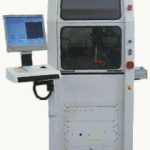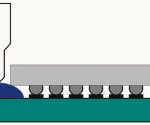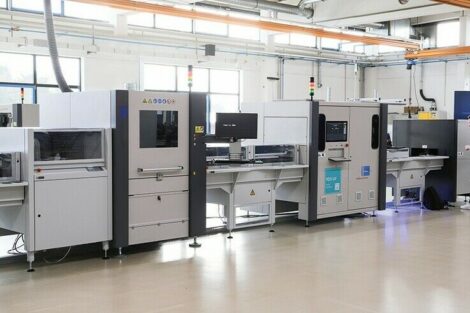As a result of extensive research, Hesse & Knipps has released its next generation of dispensing technology equipment, the DJ 335. Besides typical dispensing tasks, such as glue deposition or package encapsulation, the machine is also exceptionally capable of performing highly sophisticated flip-chip underfill dispensing processes.
It’s a widely accepted experience that multiple different factors can disturb a continuous dispensing-process procedure. In this dispenser DJ 335 (figure 1), changing flow characteristics and viscosity of dispense materials are compensated by a product heating station and the use of a volumetric dispense valve. The positioning accuracy of the dispense needle is an even more critical factor. Here, we will briefly show the capabilities of the newly developed dispenser for operations in difficult-to-handle underfill processes.
For an underfill process, the dispense needle has to evenly and precisely follow the chip edge in a proximate distance. There are the main parameters needle height, distance of the needle to the chip edge along the dispense track and the volume flow of the material. They have to be controlled in a way that the entire flip-chip component will be underfilled, and no excess material can migrate to the surface of the chip.
Three methods
As shown in figure 2, a low-viscosity liquid is dispensed on the substrate, next to a mounted and soldered flip chip. The capillary effect lets the liquid flow under the chip into the gap formed with the substrate, until the entire component area is fully covered. The flow behavior of the material and the chip size define the dispense method (see figure 3 for three different procedures).
The one-side-dispensing procedure can be used for underfilling of small chips. For larger components, the dispensing step from one side needs to be repeated after the previous deposit has been absorbed. The two-side-dispensing method can cause air bubbles under the chip which are typically not allowed. The precise positioning of the material track is the main requirement for an even flow timing and thus the utilization of the entire system which defines its productivity. This is valid for all three methods shown.
If a typical distance between flip chip and substrate is around 40 to 60µm (1.6 to 2.4 mil), it can be expected that the required needle-placement tolerance relative to the chip position is smaller than 15µm (0,6 mil), and the required height accuracy relative to the substrate surface is below 10µm (0.4 mil). See figure 4 for the wetting angle.
In case of the one-side-multiple dispensing (figure 3), the exact placement of the dispensed tracks defines the flow speed of the material. A methodically calculated and fixed timing between the deposition of sequenced dispense tracks requires the previous supplied material track to have undergone the flow process, before dispensing of a following track is possible.
For the exact placement of the needle tip, it is necessary to exactly recognize the contour of the mounted flip chip. The dispenser includes a high-resolution pattern recognition system to guarantee precise chip detection. Two independently programmable light sources with vertical light through the camera lens and a diffuse ring light with exchangeable light-color capability offer optimal illumination, which is necessary for exact pattern recognition. Even tilted chips can be determines with this system.
Dispens program and chip-geometry data
In general, a dispense program will always be accompanied with the data of the perceived chip geometry. With an accuracy of ±10µm (±0.4mil) the dispense needle will be placed to the chip edge. A height sensor guarantees a dispense height accuracy of ±10µm (±0.4mil).
Before starting the dispense process, an automatic XYZ-calibration is completed, necessary for a precise setting of any associated dispense needle. A micro-scale device is used to calibrate the dispensed mass of material, thereby specifying the flow behavior of this material formulation.
The user-friendly software offers a number of pre-defined dispense patterns, which can be customized for every single application just by varying a few main parameters. For example, the dispense pattern for a fillet ring (figure 5) was defined by the adjustments of two positions only.
Through simple drag-and-drop operations with the computer mouse, the patterns can be adjusted to the chip size during programming. Figure 6 shows a collection of pre-defined dispense patterns which can be arranged to form complex structures. Figure 7 shows a snow-flake-type dispense pattern which was generated from uncomplicated line patterns. These kinds of customized patterns can be stored in a template library. By definition of two geometrical co-ordinates, these pattern templates can be easily adjusted to produce a required chip outline.
The continuous path control of the dispenser with a dynamic position tolerance of 5µm ( 0.2mil) identifies the needle speed in any position of a trajectory, and can control the proportional material flow. This means that regardless of a change in dispense speed the dispensed track volume remains always the same.
A level-control device senses and reports the remaining amount of dispense material in a cartridge. Production data are available in real-time and can be used for analysis any time. The modern housing of the dispensing machine complies with current safety requirements. A suction system allows processing of materials which are harmful to health or environment.
A high dispense speed and the potential utilization of up to five different valves which may be organized in groups guarantee the high productivity of this system. The deployment of a number of various handling and index-systems allow the installation of the dispenser into complex production lines with host-based manufacturing monitoring and control. In multi-track solutions, up to four applications can be transported and processed in parallel.
ZUSAMMENFASSUNG
Mit einem jetzt entwickelten, vielseitig einsetzbaren Dispenser lassen sich nicht nur einfache, sondern auch höchst komplizierte Pattern sowie Underfiller-Material für Flip-Chip-Packages dosieren. Diese neue Maschinengeneration zeichnet sich zudem durch hohe Präzision sowohl in der Positionierung der Dispensnadel auf dem Substrat als auch in der Dosierung des flüssigen Materials durch Anwendung eines volumetrischen Verfahrens und Temperaturkompensation aus.
RESUMÉ
Avec un distributeur récemment mis au point et utilisable dans des domaines multiples, il est possible de doser non seulement des formes simples, mais aussi plus compliquées telles que le matériau de remplissage de logiciels à puce flip. Cette nouvelle génération de machines se caractérise en outre par sa haute précision aussi bien dans le positionnement de l’aiguille du distributeur sur le substrat que dans le dosage du matériau liquide en employant un procédé volumétrique et la compensation de température.
SOMMARIO
Grazie ad un dispenser adesso sviluppato per applicazioni molto versatili è possibile dosare non solo pattern semplici, bensì anche altamente complessi nonché materiali Underfiller per Flip-Chip-Packages. Questa nuova generazione di macchine è inoltre caratterizzata dall’elevata precisione sia nel posizionamento dell’ago dispenser sul substrato che nel dosaggio del materiale fluido grazie all’applicazione di un processo volumetrico e di compensazione termica.
Share:

















